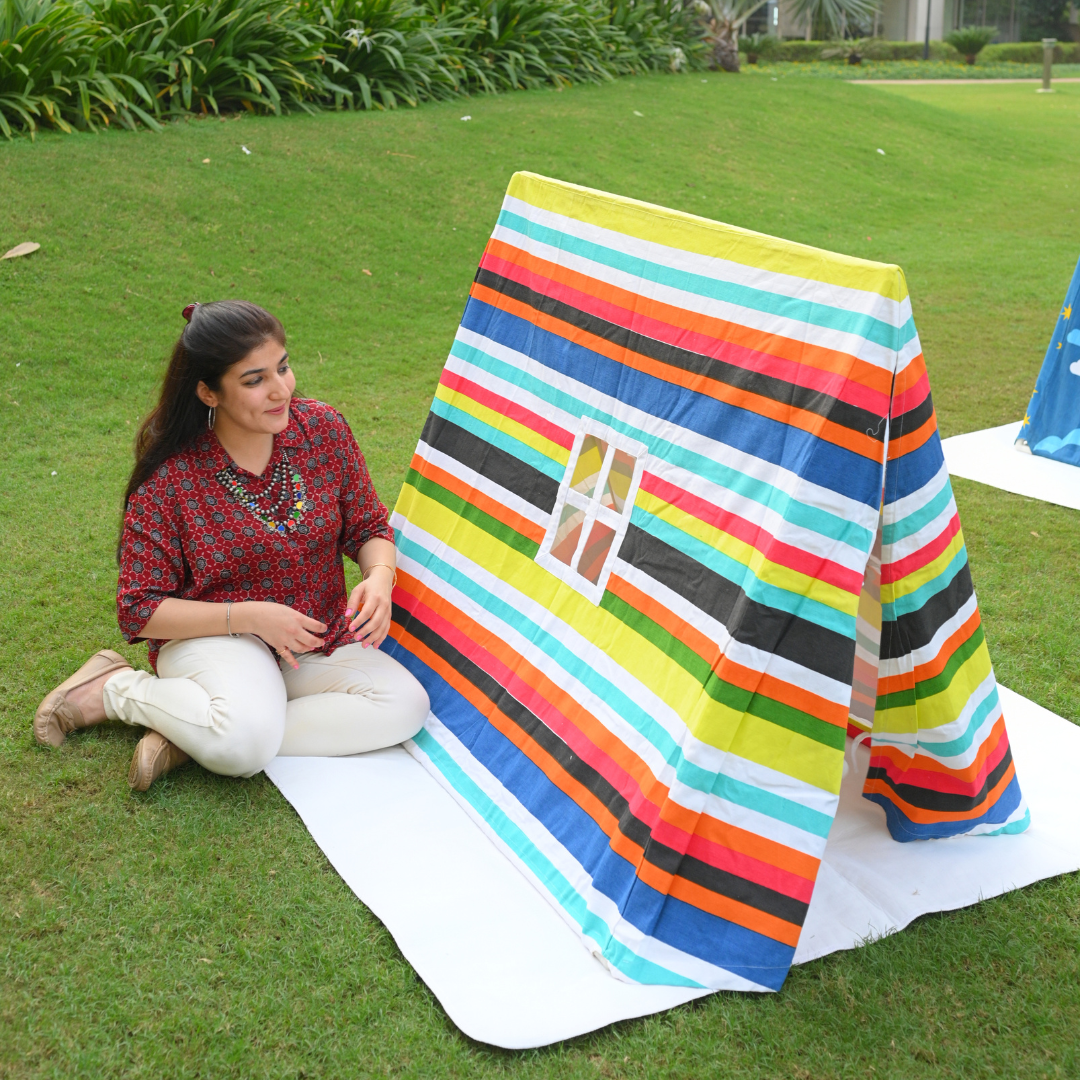There’s something magical about play tents. The moment you set one up in the living room or the backyard, it becomes more than just fabric and poles—it transforms into a castle, a pirate ship, or a quiet nook where your child’s imagination blooms. Play tents invite creativity, give children their own space, and keep playtime contained in a way that feels tidy to parents. But alongside that magic, there’s an important question every parent has to ask: Is it safe?
Play tents are, at first glance, harmless. They’re soft, lightweight, and designed for kids. But that doesn’t mean there aren’t risks to consider. The truth is, when children crawl inside a tent and shut the flaps, you’re giving them a little world of their own. It’s a gift—but it’s also a responsibility. Understanding play tent safety isn’t about stripping away the fun; it’s about making sure that the joy of a tent never gets overshadowed by preventable accidents.
Let’s look at what every parent should know to create the safest, happiest play tent environment possible.
Why Play Tent Safety Matters More Than You Think
Play tents have become a staple in many households, and for good reason—they’re cozy, affordable, and give kids a space that feels like theirs. But that “private space” can also mean less parental visibility. Toddlers can get tangled in ties, curious preschoolers might drag unsafe objects inside, and in rare cases, tents can collapse or overheat if placed poorly.
When you think about safety, you’re not just protecting your child from falls or bumps—you’re safeguarding their imagination. When a play tent feels safe, kids can play without fear, parents can relax without hovering, and the tent becomes what it’s meant to be: a spark for creativity, not a cause for worry.
Choosing the Right Play Tent from the Start
Safety begins long before the tent is even in your home. Parents sometimes overlook the importance of material, design, and construction when they buy that first tent. But the difference between a safe play tent and one that’s just “cute” is huge.
Look for tents made with non-toxic, breathable fabrics. Kids love to spend long stretches inside their tents—sometimes napping, sometimes playing with stuffed animals—and that means you want a material that won’t trap heat or emit chemical smells. The stitching matters, too. Loose seams or poorly reinforced corners can fray quickly, leading to tears or sharp edges where poles poke through.
Equally important is the frame. Play tents should have sturdy but lightweight supports—strong enough to hold the structure, but not heavy enough to injure a child if the tent tips over. Avoid overly complex tent poles or those with tiny detachable parts; small pieces are a choking hazard, and a safe tent should never have components that a child could accidentally swallow.
Placement Is Everything
Where you put a play tent changes how safe it is. Parents sometimes pop a tent anywhere there’s space, but thinking carefully about placement is one of the simplest and most effective safety measures you can take.
A tent in the middle of a room might seem fine until you notice it’s right in the path of running feet—or worse, right by a set of stairs. Play tents should always have a buffer zone. Keep them away from fireplaces, heaters, radiators, or anything with open flames. This isn’t just about fire risk—heat can make the tent uncomfortably warm inside, and fabrics can retain that warmth long after the source is gone.
Watch out for overhead hazards, too. Hanging light fixtures, ceiling fans, or shelves with items that could tumble down should be avoided. A tent might seem like a ground-level activity, but children often reach, tug, and climb in ways you don’t expect.
Airflow: The Overlooked Safety Detail
One of the most underestimated aspects of play tent safety is airflow. Kids adore the feeling of closing the flaps and making the tent their “secret world,” but those cozy little hideaways can get stuffy quickly.
Choose a tent with mesh windows or breathable panels to ensure circulation. Even in a cool room, tents can trap heat, especially when more than one child is inside. Always check the temperature inside the tent after a few minutes—you might be surprised by how warm it gets.
If your tent has a door flap, make sure your child knows it should stay partially open unless you’re right there supervising. That simple step helps maintain airflow and reassures your child they can easily get out if they feel uncomfortable.
Supervision Without Smothering
One of the joys of a play tent is that it gives children a sense of independence. They love “owning” that little patch of space and making it their own. But here’s the truth: no matter how safe a tent is, supervision matters.
Supervision doesn’t mean you have to sit inside the tent with your child—it just means staying aware. Peek in now and then, check what toys they’ve dragged inside, and be mindful of how long they’ve been playing there. For toddlers especially, it’s worth staying close during the first few times they use the tent, just to see how they interact with it. Do they try to climb on top? Do they pull too hard on the frame? Those early observations help you anticipate what might go wrong—and prevent it.
The Hidden Hazards Inside the Tent
Parents often focus on the structure of the tent itself, but what goes inside can be just as important. It’s easy for kids to haul every toy they own into their tent, and sometimes that means small parts, tangled cords, or sharp objects sneak in, too.
Set boundaries early. Explain to your child what’s allowed inside the tent—soft toys, blankets, and books are fine. Long strings, breakable objects, or anything with batteries that can leak should stay out. If your child has a tablet or small electronics they like to bring in, keep an eye on overheating, especially if the device is plugged in.
You might also consider adding a soft mat or rug under the tent. Not only does it make playtime cozier, but it also cushions any tumbles, especially on hardwood or tile floors.
Teaching Tent Etiquette
This might sound funny—tent etiquette? But teaching kids how to use their play tent is just as important as choosing the right one.
Show them how to get in and out without tugging the tent to the side. Explain that tents aren’t for climbing; even the strongest frame isn’t meant to be a jungle gym. And if your child has siblings or friends over, remind them that the tent is for playing, not wrestling.
Setting these expectations early helps the tent last longer and keeps play sessions calmer and safer. Kids love rules when they’re framed as “how to keep the magic alive”—you might be surprised by how eager they are to take care of their little hideout.
Regular Safety Check-Ins
Like anything your child uses daily, a play tent needs occasional attention. Seams can loosen, poles can bend, and fabric can tear. Make a habit of doing quick check-ins when you clean up toys.
Are the poles still snug and secure? Are any corners fraying? Does the fabric still look breathable and fresh, or is it starting to trap odors? These aren’t just cosmetic issues—small wear-and-tear can lead to larger safety risks if ignored.
If you notice any major damage, it’s better to pause play until you repair or replace the tent. It might feel like overkill, but children’s tents are meant to be safe sanctuaries, not something that causes more worry than joy.
Outdoor Tent Safety
Play tents aren’t just for the indoors. On sunny days, many parents set them up in the yard for shade-filled playtime. But outdoor tents come with their own safety checklist.
Choose a flat, stable surface so the tent won’t tilt or collapse. Be cautious of the wind—what seems like a light breeze can easily knock over a lightweight structure, or worse, send it tumbling across the lawn with your child inside.
If the tent isn’t specifically designed for outdoor use, don’t leave it exposed to harsh sunlight for hours. Some fabrics can fade, weaken, or even overheat. And of course, always bring the tent inside at the first sign of rain or storms.
Why Safety Creates More Fun
It might feel like a lot to think about—placement, materials, supervision, airflow—but here’s the thing: safety actually makes play tents more fun.
When you know your child’s tent is secure, you can relax and let them enjoy it to the fullest. They can turn it into a reading nook, an art station, or even a sleepover fort, and you won’t have to hover nervously every time they zip up the flap.
Play tents aren’t just toys—they’re little pockets of independence. And when kids feel safe in their space, they explore more, create more, and feel more confident.
Suggested Reading: Handmade vs. Store-Bought Crochet Rattles
Conclusion: A Safe Tent, A Happy Child
At the end of the day, a play tent isn’t just fabric and poles—it’s a space for giggles, secrets, and dreams. But behind every magical hideout, there’s a parent making sure that magic stays safe. From choosing the right materials to teaching gentle tent etiquette, every step you take adds to the joy your child feels when they crawl inside.
If you’re looking for thoughtfully designed play tents and baby essentials that put safety and comfort first, you’ll find plenty of inspiration at https://happymattystore.com/. Because when play spaces are made with care, kids don’t just play—they thrive.



